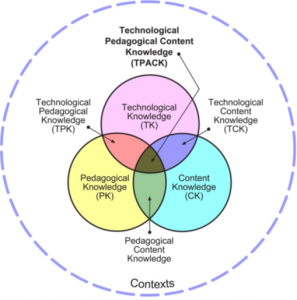Battle of the Education Technology Models
Koehler & Mishra’s Technological Pedagogical Content Knowledge model (better know as TPACK) presents a method for teachers to develop technology into their teaching practice while trying to maintain a balance of its primary elements: technology, pedagogy, content, and knowledge. By understanding TPACK’s main principals a teacher will be better able to understand the different types of technology levels, when they should be best utilized, and how. These levels are outlined in Romrell, Kidder, & Wood’s Substitution Augmentation Modification Redefinition model (SAMR).

TPACK Model: Koehler, M & Mishra, P. (2009)
The SAMR model is broken into its four core sections:
Substitution – Technology is used as a substitute for a lesson with no real change to the way the lesson is done.
Augmentation – Technology is used as a substitute for a lesson with functional changes to the way the lesson is done.
Modification – Technology allows for a redesign of the lesson
Redefinition – Technology allows for the lesson to be done in a way it could not have been done without the technology
SAMR, as outlined by its authors, breaks down the varying levels in which technology can be applied to a lesson or learning activity. If applied correctly SAMR and TPACK can work well together in guiding educators to finding and implementing tech into their classroom. But that does not mean that everything that SAMR and TPACK offer is appropriate or correct.
When reading about how the authors of SAMR felt it should be implemented I felt they went a little too far and were rigid in their assessments. They claim that redefinition, and to a lesser extent modification, are what educators should be always striving to achieve in their technology focused lessons. I hesitate to agree with them under the principle that it is important not to lose sight of the goals of your lesson/exercise. If the goal is to learn the tech, then these focus’ may be appropriate but otherwise it is possible for the tech to suddenly overshadow the point of the lesson. When building a lesson with tech a teacher should ask themselves, is the tech distracting from the point of the lesson and the research methods? If so, it may be necessary to reassess the use of said tech. The SAMR model appears to focus on the tech over the learning goals/outcomes and that is why it needs to be paired with the TPACK model. Together, an educator will have a guideline in which to assess and implement tech into their curriculum.
SAMR further pushes mLearning as the future of tech in the classroom. I mostly agree with the merits of the technology and do see in the future a greater implementation of the tech but, for now, we are limited by budget and equity concerns. Schools have limited budgets and, in the school I teach at, a device is not supplied or available for every student. Because of this, their can be a divide among the students who have devices and those who do not. Due to this reason I occasionally hesitate to endorse the strict use of mobile learning without a way for the “have not” students to participate as well.
MLearning does have its advantages as outlined by Romrell, Kidder, & Woods. Mobile devices do allow for students to be situated and connected with a personalized device of their own. This can help students learn quicker and with more familiarity than if they used an unfamiliar device. A drawback of personalization is that students can have apps and games on their devices that distract from the learning process. Most students I have interacted with can overcome the temptation to play games but there are a few that cannot make it through a class without playing one much to the detriment of their engagement and education.

Romrell, Kidder, & Woods (2014)
It’s important to remember that the realities of teaching are that most educators are generally not well versed in making mobile apps or building with technology and it is not reasonable to expect them to be. Teachers can utilize apps and tech, but it is unlikely they will have the time, resources, or knowledge to create them. Most teachers are at the mercy of tech developers and generally they are not giving their products away without a price tag or other monetary motives which can open up questions of ethics among other things.
TPACK offers the superior model for implementing tech into lessons when compared to SAMR. SAMR does have its merits in outlining what levels of tech implementation are available and what they are. The real challenge id for educators to apply the correct level of tech with the pedagogical goals of their lessons.
To conclude I will leave you with this quote from Koehler & Mishra (2009):
“Teaching with technology is a difficult thing to do well. The TPACK framework suggests that content, pedagogy, technology, and teaching/learning contexts have roles to play individually and together. Teaching successfully with technology requires continually creating, maintaining, and re-establishing a dynamic equilibrium among all components.”
References:
Hamilton, E.R., Rosenberg, J.M. & Akcaoglu, M. (2016). The Substitution Augmentation Modification Redefinition (SAMR) Model: a Critical Review and Suggestions for its Use.
Koehler, M. & Mishra, P. (2009). What is Technological Pedagogical Content Knowledge (TPACK)?. Contemporary Issues in Technology and Teacher Education, 9(1), 60-70. Waynesville, NC USA: Society for Information Technology & Teacher Education. https://www.learntechlib.org/primary/p/29544/.
Romrell, D., Kidder, L.C., Wood, E. (2014).The SAMR model as a framework for evaluating mLearning. Online Learning Journal, 18(2).https://files.eric.ed.gov/fulltext/EJ1036281.pdf
TechTrends 60(5), 433-441. https://doi.org/10.1007/s11528-016-0091-y